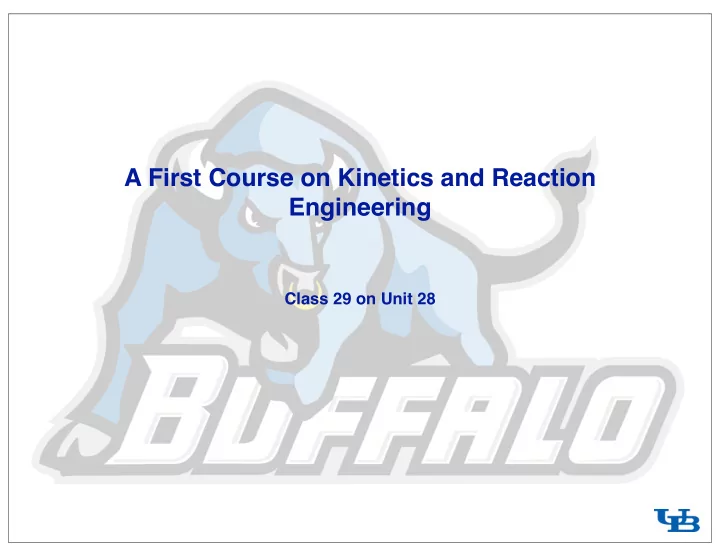

A First Course on Kinetics and Reaction Engineering Class 29 on Unit 28
Where We’re Going • Part I - Chemical Reactions • Part II - Chemical Reaction Kinetics • Part III - Chemical Reaction Engineering ‣ A. Ideal Reactors ‣ B. Perfectly Mixed Batch Reactors ‣ C. Continuous Flow Stirred Tank Reactors ‣ D. Plug Flow Reactors ‣ E. Matching Reactors to Reactions - 28. Choosing a Reactor Type - 29. Multiple Reactor Networks - 30. Thermal Back-Mixing in a PFR - 31. Back-Mixing in a PFR via Recycle - 32. Ideal Semi-Batch Reactors • Part IV - Non-Ideal Reactions and Reactors 2
Selecting a Reactor Type • First Considerations • CSTR versus PFR ‣ Safety: Are any of the ideal reactor ‣ In a CSTR, the reaction only takes types inherently risky with respect to place at the final conditions safe operation? - low reactant, high product ‣ Practicality: Can any of the ideal reactor ‣ In a PFR, the reaction starts at the inlet types be eliminated from consideration conditions and occurs at continually for practical reasons? changing conditions, only reaching the ‣ Existing technology: Is this reaction CSTR conditions at the end of system, or one that is chemically processing similar, already being operated - high reactant, low product commercially? • Trade offs • Batch versus Continuous ‣ When one ideal reactor type is not ‣ Batch processing is more labor clearly preferred, a quantitative analysis intensive and costly than continuous of both may be warranted - Best for chemicals where the total ‣ This will be necessary for the selected amount to be produced is small and reactor even if there are no trade-offs the price of the product is high ‣ Augmented ideal reactors may offer - Pharmaceuticals and specialty advantages chemicals ‣ Adding another piece of equipment or ‣ Continuous processing flow line to an ideal reactor type can - Best when the amount to be cause it to behave differently than the processed is large ideal reactor type would by itself - Commodity chemicals 3
Questions? 4
Mid-Semester Scores • Calculation of Mid-Semester Score ‣ 5% - Quizzes (Units 2-25) ‣ 5% - Worksheets (through 10/30/15) ‣ 5% - Homework Effort (1 - 17, 19 and 21) ‣ Mid$Semester$Score$Distribu0on$ 5% - Homework corrections (1 - 17, 19 and 21) and surveys (1 - 22) 30" ‣ 10% - MATLAB Assignments (1 - 3) 25" ‣ 60% - Exam 1 ‣ Renormalize result to 100 points 20" • Grades 15" ‣ 90 - 100 = A ‣ 80 - 89 = B 10" ‣ 70 - 79 = C ‣ 60 - 69 = D 5" ‣ 11.1 - 59 = F • Statistics 0" 0"'"10" 10"'"20" 20"'"30" 30"'"40" 40"'"50" 50"'"60" 60"'"70" 70"'"80" 80"'"90" 90"'"100" ‣ Average: 73.6 ‣ Standard deviation: 14.1 ‣ High: 99.2 ‣ Low: 11.1 5
Where We’re Going • Part I - Chemical Reactions • Part II - Chemical Reaction Kinetics • Part III - Chemical Reaction Engineering ‣ A. Ideal Reactors ‣ B. Perfectly Mixed Batch Reactors ‣ C. Continuous Flow Stirred Tank Reactors ‣ D. Plug Flow Reactors ‣ E. Matching Reactors to Reactions - 28. Choosing a Reactor Type - 29. Multiple Reactor Networks - 30. Thermal Back-Mixing in a PFR - 31. Back-Mixing in a PFR via Recycle - 32. Ideal Semi-Batch Reactors • Part IV - Non-Ideal Reactions and Reactors 6
Exam 2 • All procedures will be the same as Exam 1 • There will be 6 short answer questions worth 5 points each • There will be 2 quantitative reaction engineering problems worth 35 points each 7
Solution to the Practice Exam • Posted with other solutions to homework problems 8
Recommend
More recommend